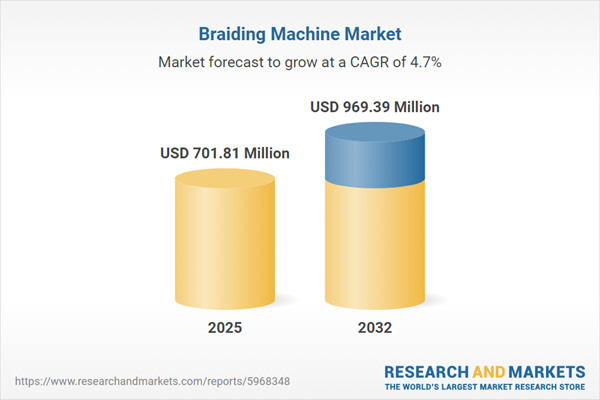Speak directly to the analyst to clarify any post sales queries you may have.
The global braiding machine market is advancing rapidly, driven by transformative technology, evolving application needs, and heightened demand for high-performance, customized solutions across core industries. As senior decision-makers navigate a landscape shaped by automation, innovation, and regulatory complexity, informed insights are essential to maintain competitiveness and future-proof production capabilities.
Market Snapshot: Braiding Machine Market Growth and Trends
The braiding machine market grew from USD 671.46 million in 2024 to USD 701.81 million in 2025, and is projected to reach USD 969.39 million by 2032, supported by a CAGR of 4.69%. This stable growth is propelled by increased adoption of technologically advanced machinery, strategic responses to global supply chain shifts, and expanding applications in sectors such as aerospace, medical devices, and infrastructure. Market participants are responding to regulatory changes and evolving customer requirements through accelerated investment in digital transformation and sustainable production.
Scope & Segmentation
Comprehensive coverage includes a detailed analysis of technologies, product types, applications, and regional markets:
- Machine Types: Circular braiding machines, horizontal braiding machines, vertical braiding machines
- Machine Drive Types: Fully automatic, manual, semi-automatic braiding machines
- Braiding Types: Double braid, single braid, triple braid machines
- Material Used: Composites & specialty materials, metallic materials (aluminum, copper, stainless steel), natural fibers (cotton, hemp, silk, wool), synthetic fibers (acrylic, nylon, polyester, spandex)
- Application: Aerospace, automotive (wires & cables, braided hoses, seatbelt webbing), consumer goods, electrical, industrial, medical (catheters, medical tubing, compression garments, surgical sutures), textiles (fashion apparel, home textiles, narrow fabrics)
- Product Output: Narrow fabrics, ropes & cords, tubing & sleeving, wires & cables
- Geographic Regions: Americas (North America, Latin America), Europe, Middle East & Africa (Europe, Middle East, Africa), Asia-Pacific (China, India, Japan, Australia, South Korea, Indonesia, Thailand, Malaysia, Singapore, Taiwan)
- Company Coverage: Including but not limited to industry leaders such as Herzog GmbH, Steeger USA, Braidwell Machine Co., Spirka Schnellflechter GmbH, Maschienenfabrik Niehoff GmbH & Co. KG, Mayer & Cie., Susmatex, and Kyang Yhe Delicate Machine Co.
Braiding Machine Market: Key Takeaways for Strategic Leaders
- Rapid adoption of digital twin technology and predictive analytics solutions is enhancing operational visibility and performance optimization for manufacturers.
- Sustainability is becoming integral, with increased research and deployment of bio-derived and recycled fiber processing, impacting both machine design and materials sourcing.
- Customizable machine architectures and modular systems support agile reconfiguration for diversified product demands and facilitate integration with modern supply chains.
- Collaborative R&D and technology partnerships with material science specialists are accelerating product validation cycles and expanding addressable markets.
- Regional shifts, especially in Asia-Pacific and North America, reflect re-shoring trends, government incentives, and expanding infrastructure needs, creating new growth nodes.
- Manufacturers are transitioning from transactional sales models to service-led, outcome-based offerings to deepen customer engagement across asset lifecycles.
Tariff Impact: Strategic Responses to 2025 Policy Changes
Recent United States tariffs on braiding equipment and feedstock materials have altered the global competitive landscape. Manufacturers have adapted by localizing assembly, seeking exemptions, and reevaluating supplier partnerships, while also innovating around materials and machine configurations. These strategies have impacted logistics, accelerated investment in local production capabilities, and contributed to broader shifts in R&D approaches and cost management across supply chains.
Methodology & Data Sources
This analysis employs a mixed-method approach, integrating primary interviews with senior industry stakeholders and quantitative surveys on market practices. Secondary validation through industry reports, patent filings, and regulatory documents ensures data integrity and comprehensive segmentation.
Why This Report Matters
- Empowers leadership teams with actionable insights for navigating digital transformation, evolving compliance demands, and supply chain complexity in the braiding machine sector.
- Supports precise decision-making with in-depth segmentation, competitor intelligence, and sustained trend analysis across regions and applications.
Conclusion
This report equips senior stakeholders with a strategic framework to drive innovation, manage risks, and achieve performance optimization in a dynamic braiding machinery market environment.
Additional Product Information:
- Purchase of this report includes 1 year online access with quarterly updates.
- This report can be updated on request. Please contact our Customer Experience team using the Ask a Question widget on our website.
Table of Contents
3. Executive Summary
4. Market Overview
7. Cumulative Impact of Artificial Intelligence 2025
Companies Mentioned
The companies profiled in this Braiding Machine market report include:- Alfa Flexitubes Pvt. Ltd.
- B And B Machines Private Limited
- Braidwell Machine Co.
- Fletcher Industries & Fletcher International
- Geesons International
- Herzog GmbH
- HSIANG CHUAN MACHINERY
- JAYSON ENGINEERING & MFG. CO.
- Karg Corporation
- Kyang Yhe Delicate Machine Co., Ltd.
- LORENZATO S.r.l.
- Magnatech International, Inc.
- Maschinenfabrik Niehoff GmbH & Co. KG
- Mayer & Cie. GmbH & Co KG
- OMEC S.r.l.
- Spirka Schnellflechter GmbH
- SRICHAND ENGINEERING & MOULDING CO.
- Steeger USA by Machine Solutions Inc.
- Susmatex
- TALLERES RATERA S.A.
- TapeFormers Ltd
- Wardwell Braiding Co.
- Xiamen Yitai Industrial Co.,Ltd
Table Information
| Report Attribute | Details |
|---|---|
| No. of Pages | 187 |
| Published | November 2025 |
| Forecast Period | 2025 - 2032 |
| Estimated Market Value ( USD | $ 701.81 Million |
| Forecasted Market Value ( USD | $ 969.39 Million |
| Compound Annual Growth Rate | 4.6% |
| Regions Covered | Global |
| No. of Companies Mentioned | 24 |









